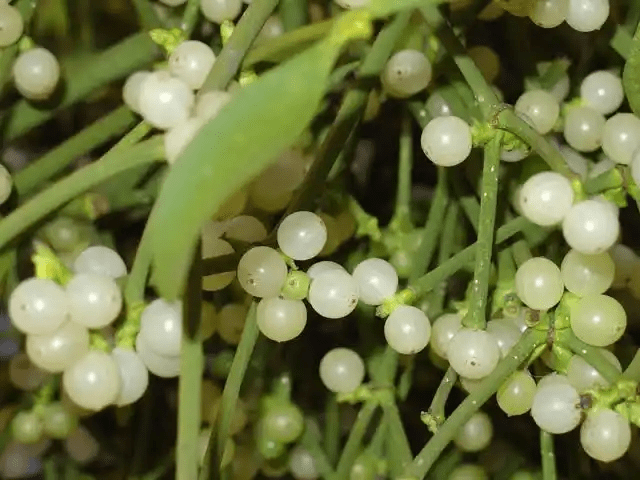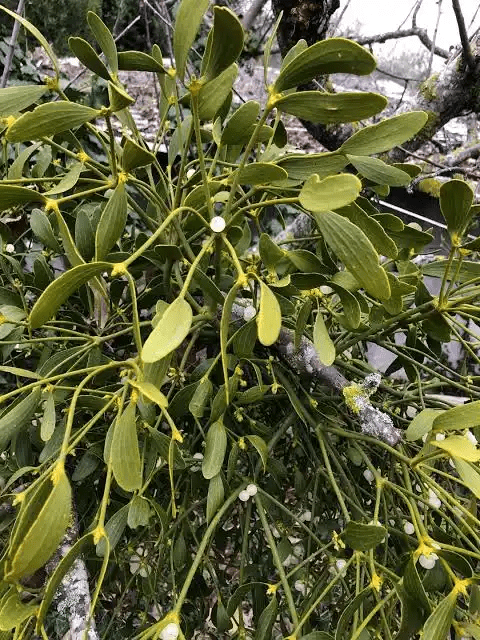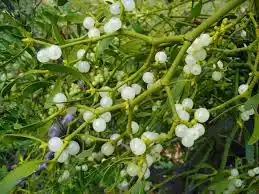The European Mistletoe, scientifically known as Viscum album, holds a significant place in various cultural traditions, especially during the winter holiday season. This fascinating plant is a hemiparasitic evergreen species belonging to the Santalaceae family, found across Europe and parts of Asia.
Characterized by its small, oval-shaped leaves and distinctive translucent white berries, Viscum album often grows on the branches of deciduous trees, particularly apple, oak, and other hardwood trees. It forms dense spherical masses, creating a striking sight against the bare winter branches, hence its association with festive decorations.
Culturally, mistletoe has garnered considerable attention and symbolism. It’s traditionally linked to various beliefs and customs, particularly during winter celebrations. One of its most well-known traditions involves hanging mistletoe in homes during the holiday season.
According to this custom, people standing beneath it are encouraged to share a kiss, adding a playful and affectionate element to gatherings.
Beyond its cultural significance, mistletoe has also intrigued scientists due to its unique nature as a parasitic plant. While it photosynthesizes and produces its food, it relies on the host tree for water and minerals.
This symbiotic relationship, though sometimes harmful to the host in large infestations, is a fascinating aspect of mistletoe’s biology.
Interestingly, mistletoe has a long history of medicinal use in various cultures. Traditional herbal medicine often utilized mistletoe extracts for conditions like hypertension, epilepsy, and even cancer.
Contemporary research is exploring its potential therapeutic properties, particularly in cancer treatment, although further studies are needed to validate these claims.
Caution is warranted with mistletoe consumption, as parts of the plant can be toxic if ingested in large quantities. It’s advisable to seek guidance from experts before using mistletoe for any medicinal purposes.
Conservation efforts are essential for mistletoe, as changes in land use and habitat destruction can impact its growth and distribution. Preservation of its natural habitats and sustainable management practices are crucial to maintain the balance between its ecological role and human traditions.
Viscum album, with its cultural symbolism, intriguing biology, and potential medicinal properties, continues to captivate both scientists and enthusiasts alike, adding a touch of wonder to our winter landscapes and holiday celebrations.
The Botanical Description of Viscum album
1. Life: Viscum album, commonly known as mistletoe, is a hemiparasitic plant that belongs to the Santalaceae family. Unlike fully parasitic plants, mistletoe can perform photosynthesis but also relies on host trees for water and nutrients.
2. Appearance: Mistletoe has a distinctive appearance with evergreen leaves and waxy, white berries. The leaves are leathery and often arranged in opposite pairs along the stems. The plant exhibits a characteristic bushy and clumpy growth pattern on the branches of host trees.
3. Flowers: Mistletoe flowers are small, inconspicuous, and greenish-yellow. They typically bloom in clusters, contributing to the overall ornamental aspect of the plant, especially during the winter months when the host tree may have shed its leaves.
The Geographic Distribution of Viscum album
1. Natural Habitat: Viscum album is found in various regions, spanning Europe and Asia. It thrives in deciduous trees, including apple, poplar, and pine. The plant establishes itself by germinating on branches, forming a connection with the host tree for sustenance.
2. Range: The geographic distribution of mistletoe extends to different climatic zones, adapting to both temperate and subtropical environments. The plant’s ability to thrive in diverse conditions contributes to its prevalence in various ecosystems.
3. Ecological Significance: Mistletoe plays a role in the ecology of its habitat by influencing the nutrient dynamics of host trees. While it can weaken the host, it also provides food and shelter for various bird species. Understanding its distribution is essential for assessing its impact on forest ecosystems.
The Chemical Composition of Viscum album
1. Active Compounds: Mistletoe contains a range of compounds, including viscotoxin and lectins, which contribute to its biological activities. These compounds have been studied for their potential medicinal properties, though caution is warranted due to mistletoe’s toxic nature.
2. Medicinal Properties: Despite its toxicity, mistletoe extracts have been explored for their potential anti-cancer properties. Some traditional medicine practices have used mistletoe to treat various ailments, although scientific research is ongoing to validate these claims and explore potential therapeutic applications.
3. Research and Applications: Ongoing research into the chemical composition of Viscum album is critical for understanding its potential medicinal benefits and ecological interactions. As we explore its compounds and their effects, there may be opportunities for developing new pharmaceuticals or gaining insights into ecosystem dynamics.
Read Also: A Complete Guide to Farming Equipment and Machinery Reviews
The Medicinal Health Benefits Of Viscum album (European Mistletoe)

1. Immune System Support: Viscum album has been traditionally used to boost the immune system, contributing to overall health and resilience against illnesses.
2. Cardiovascular Health: Some studies suggest that Viscum album extracts may have cardiovascular benefits, including potential effects on blood pressure and circulation.
3. Anti-inflammatory Properties: The plant is known for its anti-inflammatory properties, which can be beneficial in managing inflammatory conditions and promoting general well-being.
4. Antioxidant Effects: Viscum album contains antioxidants that help neutralize free radicals, providing protection against oxidative stress and supporting cellular health.
5. Stress Reduction: Herbal preparations of Viscum album have been used for their potential calming effects, helping reduce stress and anxiety.
6. Pain Relief: Traditional uses include the alleviation of pain, making Viscum album a potential option for managing discomfort associated with various conditions.
7. Respiratory Health: The plant has been employed to support respiratory health, potentially easing symptoms of conditions such as asthma and bronchitis.
8. Antiviral Properties: Some studies suggest that Viscum album may have antiviral properties, making it a subject of interest for viral infections.
9. Cancer Supportive Care: In certain complementary medicine practices, Viscum album extracts are used to support cancer patients, particularly in managing side effects of treatments.
10. Nervous System Support: The plant is believed to have a positive impact on the nervous system, potentially aiding in conditions related to nervous system disorders.
11. Digestive Health: Viscum album has been traditionally used to promote digestive health, addressing issues such as indigestion and gastrointestinal discomfort.
12. Wound Healing: Topical applications of Viscum album extracts have been utilized for their potential role in wound healing and skin conditions.
13. Blood Sugar Regulation: Preliminary research suggests that Viscum album may have properties that contribute to the regulation of blood sugar levels.
14. Sleep Aid: The calming effects of Viscum album extend to potential benefits in promoting relaxation and improving sleep quality.
The Methods of Usage to Achieve the Provided Health Benefits Of Viscum album (European Mistletoe)
1. Tinctures: Use tinctures made from Viscum album extracts as directed by herbalists or healthcare professionals to harness its health benefits.
2. Infusions: Prepare herbal infusions using Viscum album leaves or stems for immune system support and stress reduction.
3. Topical Applications: Apply creams or ointments with Viscum album extracts topically to promote wound healing and address skin conditions.
4. Suppositories: In some traditional practices, suppositories with Viscum album extracts are used for their potential effects on the digestive system.
5. Compresses: Create compresses with Viscum album extracts for localized pain relief and to support wound healing.
6. Inhalation: Inhale the aroma of Viscum album essential oil through diffusers or diluted applications to promote relaxation and reduce stress.
7. Capsules or Tablets: Incorporate Viscum album supplements in capsule or tablet form into your routine for convenient access to its potential health benefits.
8. Subcutaneous Injections: In certain medical contexts, subcutaneous injections of Viscum album extracts are used, particularly in cancer supportive care.
9. Dietary Use: In some cultures, Viscum album may be used as a culinary herb or in herbal teas to promote digestive health.
10. Homeopathic Preparations: Homeopathic remedies made from Viscum album are utilized for specific health concerns in homeopathic medicine.
The Side Effects Of Using Viscum album Medicinal Plant
1. Allergic Reactions: Some individuals may experience allergic reactions to Viscum album, and caution is advised, especially for those with known plant allergies.
2. Gastrointestinal Issues: Excessive consumption may lead to gastrointestinal discomfort, and it’s essential to follow recommended dosages.
3. Blood Pressure Effects: Individuals with blood pressure concerns should use Viscum album cautiously, as it may influence blood pressure.
4. Drug Interactions: Viscum album may interact with certain medications, especially those affecting the cardiovascular system. Consultation with healthcare professionals is crucial.
5. Nausea and Vomiting: Some individuals may experience nausea or vomiting as a side effect of Viscum album use. Monitoring for these symptoms is recommended.
6. Skin Irritation: Topical applications may cause skin irritation in some individuals. Performing a patch test is advisable.
7. Central Nervous System Effects: Viscum album’s calming effects may cause drowsiness, and individuals should exercise caution, especially when operating machinery or driving.
8. Pregnancy and Breastfeeding: Pregnant and breastfeeding individuals should avoid using Viscum album due to potential effects on blood pressure and other factors.
9. Kidney and Liver Function: Individuals with kidney or liver issues should use Viscum album cautiously, as it may influence these organ functions.
10. Hypoglycemia Risk: Individuals with diabetes should monitor their blood sugar levels, as Viscum album may affect glucose regulation.
Read Also: 5 Medicinal Health Benefits Of Viola adunca (Hookspur Violet)
The Scientific Research and Studies of Viscum album

1. Phytochemical Composition: Scientific research on Viscum album delves into its phytochemical composition, exploring compounds such as viscotoxin and lectins. Studies aim to unravel the therapeutic potential of these compounds and their impact on human health.
2. Immunomodulatory Effects: Researchers investigate the immunomodulatory effects of Viscum album extracts. Studies explore how the plant may influence the immune system, contributing to its traditional use in supporting immune function.
3. Anti-cancer Properties: Scientific studies have examined the potential anti-cancer properties of Viscum album. Research explores its effects on cancer cells and its role in complementary cancer therapies, offering insights into novel treatment approaches.
The Safety Precautions and Recommendations In Using Viscum album Medicinal Plant
1. Professional Guidance: Seek guidance from a qualified healthcare professional before using Viscum album medicinally. Their expertise can help ensure safe and effective usage.
2. Dosage Control: Adhere strictly to recommended dosages. Excessive consumption of Viscum album may lead to adverse effects, including nausea and vomiting.
3. Allergic Reactions: Be vigilant for potential allergic reactions to Viscum album. Some individuals may be sensitive to components of the plant, leading to skin irritation or respiratory issues.
4. Pregnancy and Lactation: Avoid using Viscum album during pregnancy and lactation due to potential risks. Consult a healthcare provider for safer alternatives.
5. Interaction with Medications: Check for potential interactions with existing medications before using Viscum album. Certain compounds may interact with drugs, affecting their efficacy.
6. Harvesting Practices: If harvesting Viscum album, do so ethically and sustainably to preserve the plant’s populations and its ecosystem.
7. Mental Health Considerations: Exercise caution due to the psychoactive properties of certain compounds in Viscum album, especially for individuals with mental health conditions.
8. Children’s Use: Keep Viscum album out of reach of children. Its effects on children are not well-studied, and caution is advised.
9. Medical Conditions: Individuals with specific medical conditions, such as autoimmune disorders, should use Viscum album cautiously or avoid it altogether.
10. Side Effects Monitoring: Be attentive to any side effects or adverse reactions while using Viscum album. Seek medical attention if needed.
11. Long-term Use: Prolonged or excessive use of Viscum album may have unknown long-term effects. Use with caution and moderation.
FAQs About Viscum album Medicinal Plant
1. Is Viscum album safe for consumption?
Yes, when used appropriately and under professional guidance. However, excessive consumption should be avoided.
2. What are the known side effects of using Viscum album?
Possible side effects include nausea, allergic reactions, and, rarely, vomiting.
3. Can Viscum album be used during pregnancy or breastfeeding?
It’s not recommended, as potential risks to the fetus or infant exist. Consult a healthcare provider for advice.
4. Does Viscum album interact with medications?
Some compounds may interact with medications. Consult with a healthcare professional before use.
5. What is the recommended dosage of Viscum album?
Dosage varies, and professional advice should be sought for proper administration.
6. Can Viscum album be used for mental health purposes?
Caution is advised due to its psychoactive properties, especially for individuals with mental health concerns.
7. Is Viscum album safe for children?
Its effects on children are not well-understood; it should be kept away from them.
8. How should Viscum album be harvested sustainably?
Ethical harvesting practices help preserve the plant’s populations and its natural habitat.
9. Are there specific medical conditions that contraindicate the use of Viscum album?
Individuals with autoimmune disorders or certain medical conditions should use it cautiously.
10. Can Viscum album cause allergic reactions?
Some individuals may experience allergic reactions, and caution is advised.
11. What is the legal status of using Viscum album in different regions?
Legal status may vary, and it’s essential to check local regulations before use.
12. Are there documented cases of Viscum album overdose?
Overdose cases are rare but may lead to severe adverse effects.
13. How does Viscum album contribute to the immune system?
Studies suggest potential immunomodulatory effects, supporting its traditional use.
14. What are the traditional uses of Viscum album?
Traditionally used for various medicinal purposes, including immune support.
15. Can Viscum album be used in conjunction with herbal supplements?
Caution is advised due to potential interactions; professional advice is recommended.
16. Are there ongoing clinical trials or research on Viscum album?
Research is ongoing, exploring its potential applications and refining our understanding of its effects.

